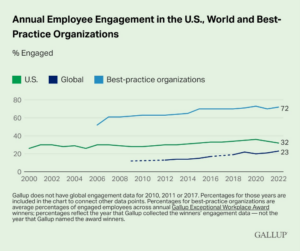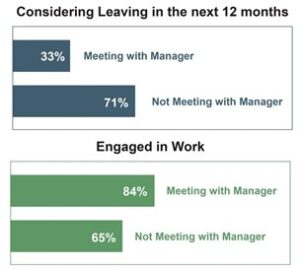“We cannot solve our problems with the same thinking we used when we created them.”
– Albert Einstein
Our friends at Gallup report interesting data emerging post-pandemic.
- Employees, when presented with options, prefer hybrid work.
- Engagement – in the U.S. and globally – is dropping.
- Employees who have meaningful conversations with their managers report higher engagement (regardless of how many days they work in or outside an office).
So how can leaders inspire engagement in the hybrid workplace? If we connect these dots, we start to form interesting conclusions. And, remembering Einstein’s observation, we can develop new solutions to long-standing engagement-at-work challenges.
Hybrid work is here to stay.
Despite the push by CEOs to bring employees together under the guise of better collaboration, stronger innovation, or an investment in culture, you cannot put toothpaste back in the tube. For many of us, where and how we work has fundamentally changed. We expect our workplaces to support productivity and flexibility, offering opportunities for robust in-person collaboration and autonomous heads-down creation. Most workplaces have figured this out – investing in the technology and processes to allow seamless transitions from online to onsite. Those that have not – and those that are forcing butts back into seats – will feel the effects as the most in-demand talent seeks greener (and more mobile) pastures.
Engagement is personal – a human challenge requiring human solutions.
After peaking in 2020, engagement globally and in the U.S. is creeping downward.
 We know disengagement is costly, from lost productivity to the investment required to refill key roles. And we know managers have a big influence on engagement, accounting for up to 70% of the difference between engaged and disengaged teams.
We know disengagement is costly, from lost productivity to the investment required to refill key roles. And we know managers have a big influence on engagement, accounting for up to 70% of the difference between engaged and disengaged teams.
So how do we address this problem? By remembering that engagement is PERSONAL. That we each stick around a job for different reasons. It is not enough to measure engagement through surveys and apps and then roll out sweeping programs based on results. By appealing to the needs of the many, we forget the needs of the one. Big programs rarely affect the emotional involvement, passion investment, and intrinsic motivation at engagement’s core. Engagement is a HUMAN challenge – and the solutions depend on humans.
Meaningful conversations make meaningful differences.
 Sigred Group’s 2023 Engagement Survey data shows direct correlations among retention, engagement, and regular manager conversations. 71% of the ~300 participants who do not meet regularly with their manager are considering leaving in the next year, compared to the 33% who are meeting with their manager. And there is an almost 20-point difference in engagement between the two groups.
Sigred Group’s 2023 Engagement Survey data shows direct correlations among retention, engagement, and regular manager conversations. 71% of the ~300 participants who do not meet regularly with their manager are considering leaving in the next year, compared to the 33% who are meeting with their manager. And there is an almost 20-point difference in engagement between the two groups.
Gallup reports that 80% of employees who say they have received meaningful feedback in the past week are fully engaged — regardless of how many days they worked in the office. But only 16% say their manager conversations were “extremely meaningful.”
One of the most critical acts of a leader is to have meaningful conversations with their employees – 15-30 minutes every week, clarifying expectations, sharing feedback, praising achievements, and optimizing strengths. We are more likely to commit to organizations in which leaders have these conversations. We will stick around, go the extra mile, deepen relationships, and bring our best selves.
Hybrid or remote is not an excuse to forego these conversations. It is the content and regularity that matters, not the medium. Here is a practical structure and sample questions to help you get meaningful.
A framework for meaningful conversations
 We stay in jobs that support our feelings of engagement. We feel engaged when our work-related needs are met. We want career opportunities where our needs align with what the employer is offering, and what WE are offering meets that employer’s needs.
We stay in jobs that support our feelings of engagement. We feel engaged when our work-related needs are met. We want career opportunities where our needs align with what the employer is offering, and what WE are offering meets that employer’s needs.
Simple, right? Have we solved the engagement conundrum? No. For many employees, it is not easy to define and communicate what they need. They may lack the self-awareness to describe their values and priorities. Leaders often do not ask questions that get to the heart of what engages their team members, lacking the skills, practice, and accountability to have the conversations – and falling prey to assumptions and naïve optimism that our people are doing just fine. Time for some skill-building.
My Needs
Let us begin with the individual’s needs. Human motivation has long fascinated researchers. What makes people happy? Why do they do what they do? What inspires and drives them?
As a leader, ask your employees – what do you uniquely need from work?
- What do you need to be at your best?
- What flexibility/autonomy do you need?
- What balance between in-person and remote is optimal?
- What motivates and interests you?
- What do you need to feel connected to our culture?
- What factors in your job are most important to you?
- What is your preferred working style?
- What do you need to feel safe at work?
My Offer
Employees – regardless of if they work remotely, onsite, or hybrid – feel more engaged when their value proposition is understood, appreciated, and recognized by their leaders and organizations. They feel motivated when leaders and organizations invest in their development, providing opportunities for them to do what they do best, to use their strengths and demonstrate their competence.
Ask your employees: what are you willing to give in exchange for the organization meeting your needs?
- What are your strengths/capabilities?
- When are you at your best/in “flow?”
- What is your unique personal brand?
- What are your superpowers?
- What are you doing (with whom and where) when you feel the most engaged?
- In what role(s) do you add optimal value?
- How can you adapt to hybrid work expectations?
- What skills and abilities do I want to develop?
Organization’s Offer
Organizations spend big money enticing people to apply, join, and stick around. But one size does not fit all, and not every employee appreciates every benefit. This is especially true when designing hybrid schedules – Mondays and Fridays might be more optimal in-person days for some, while others prefer midweek.
If there is enough alignment between what your employees need and what the organization offers, engagement is more likely to follow. To explore this match – and uncover gaps – ask your employees:
- What benefits are most appealing? Which do you most frequently use?
- What does the organization not offer that would make you feel more excited about work?
- How does your physical workspace support (or hinder) you from doing your best work?
- What materials/equipment do you need to do your work most effectively?
- How can the organization support your sense of belonging?
Organization’s Needs
Organizations want their employees – especially their highest performers – to stay, yes. But they want them to achieve goals, complete assigned tasks, take on new assignments, maintain (and deepen) their knowledge and skills, protect organizational assets, behave in alignment with norms and practices, and generally play nice with others. It is a delicate balance between the organization’s preference for compliance (do this by this time) and consistency (everyone is working onsite Tuesday-Thursday, regardless of role and personal circumstances) the individual’s yearning for autonomy (OK, but I want to do it this way because it works best for me). As organizations navigate hybrid work, this balance becomes critical.
Investigate the alignment between your employees’ offer and the organization’s needs by returning to management fundamentals:
- Communicate and reinforce organizational vision and the “big picture” – the “why”
- Clarify expectations, revising as needed – the “what”
- Empower employees to design and execute plans for the “how”
- Give regular actionable feedback on the “how,” both reinforcing (keep doing what you are doing) and redirecting (that did not work as well, what can be done differently)
- Listen for opportunities to optimize the employees’ strengths – through current or new/different assignments
- Confirm understanding – and do it all again in a week
Reminders for leaders: shift your thinking to solve your problems
- Engagement influences retention – but engagement is personal and means something different to each person (employees stay for different reasons).
- Retention, motivation, commitment – these are human challenges demanding human solutions. The individual and organization must come together to spark engagement.
- Encourage your employees to become more comfortable defining and communicating what they NEED from and what they can OFFER to work and workplaces – role model by sharing first and by asking questions during regular conversations.
For many leaders, work and the workplace changed dramatically in 2020 – and continues to evolve. Do not use hybrid or remote work as the excuse to forego meaningful conversations – talking to your employees is one of the most meaningful things you can do to support workplace engagement.
If you want to design a survey to assess your employee engagement, check out the Talent Strategy Collection course on Building Effective Engagement Surveys.
Tina is the founder of WorkJoy, a humans-at-work advisory organization offering coaching, facilitation, program consulting, speaking, and training solutions. She is a sought-after thought leader for international conferences, recently speaking at the annual SHRM and ATD events. Tina lives in Los Angeles.


